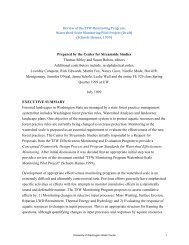Copyright 2012 Aileen M. Echiverri-Cohen - University of Washington
Copyright 2012 Aileen M. Echiverri-Cohen - University of Washington
Copyright 2012 Aileen M. Echiverri-Cohen - University of Washington
Create successful ePaper yourself
Turn your PDF publications into a flip-book with our unique Google optimized e-Paper software.
antidepressants and found that CBT involved similar brain changes as those seen with<br />
antidepressants following treatment. They argued for the superiority <strong>of</strong> CBT in strengthening<br />
prefrontal regions leading to the acquisition <strong>of</strong> emotion regulation skills where symptom<br />
improvement continues long after treatment ends. In contrast, antidepressants purportedly<br />
address amygdala hyperactivity but confer risk upon termination and may not <strong>of</strong>fer protection<br />
like CBT in maintaining treatment gains. These studies provide preliminary support for a top-<br />
down pathway <strong>of</strong> strengthening prefrontal regions to reduce amygdala reactivity in CBT, leading<br />
to therapeutic change. In summary, although PE and SER appear to converge on a final pathway<br />
in reducing amygdala reactivity, which may account for increased temporal attentional inhibition<br />
over time, PE produced earlier attentional inhibitory gains, and more sustained and stronger<br />
changes in inhibition than SER, arguing for treatment specific effects in normalizing inhibitory<br />
deficits in PTSD.<br />
Using the AB paradigm, temporal attentional inhibition improved over time. Individuals<br />
with PTSD showed increases in inhibition on AB from pre-treatment to post-treatment, with<br />
accuracy on AB on critical inhibitory lags improving over time. Although there was this effect<br />
<strong>of</strong> time on inhibition, as stated above, the effect <strong>of</strong> time was modified by the interaction with<br />
treatment modality and treatment response. Nevertheless, these findings bolster the argument for<br />
commonalities between PE and SER, particularly in light <strong>of</strong> the effectiveness <strong>of</strong> both treatments<br />
(e.g., Foa et al., 1999; Brady et al., 2000), similar neural changes to the fear circuitry <strong>of</strong> PTSD<br />
(Heym et al., 1998; Felmingham et al., 2007), and potential common pathways discussed above.<br />
One alternative explanation is that time or repeated practice could lead to subsequent<br />
improvement in inhibition as well. Time and repeated practice with attentional tasks has been<br />
44
















